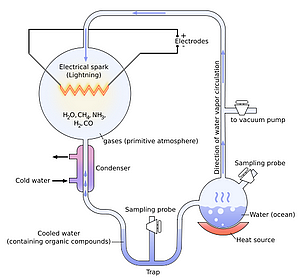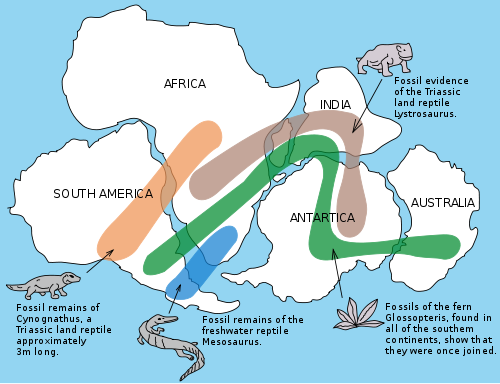ORIGIN AND HISTORY OF LIFE
Chemical evolution is the increase in complexity of chemicals that led to the first cells.
1. Today, we say that "life only comes from life."
2. However, the first cells had to arise from an increased complexity of chemicals.
A. The Early Earth
1. The Earth is about 4.6 BYA (BYA).
2. Early Earth's atmosphere differed from the current atmosphere, consisting
of:
a. water vapor,
b. nitrogen,
c. carbon dioxide,
d. small amounts of hydrogen, methane, ammonia, hydrogen sulfide, and carbon monoxide.
3. This chemical soup was inhospitable to life, and with no atmosphere, the earth was constantly bombarded by asteroids.
B. Monomers Evolve
1. Oparin/Haldane Hypothesis (1920s)
2. Experiments performed by Miller and Urey (1953) showed that
gases (methane, ammonia, hydrogen, water) reacted with one another to
produce small organic molecules (amino acids, organic acids).

3. Lack of oxidation and decay allowed organic molecules to form a thick, warm
organic soup.
4.
Ammonia converted from N2 in ocean vents
C. Polymers Evolve
1. Newly formed organic molecules polymerized to produce larger molecules.
2. Microspheres - cell like, composes of proteins and repeating units of amino acids
D. A Protocell Evolves
1. Before the first true cell arose, there would have been a protocell or protobiont.
2. A protocell would have a lipid-protein membrane and carry on energy metabolism.
3. Coacervates were proposed by Oparin as a possible protocell
A coacervate is a tiny spherical droplet of assorted organic molecules (specifically, lipid molecules) which is held together by hydrophobic forces from a surrounding liquid.
E. A Self-Replication System Evolves
In living systems, information flows from DNA ? RNA ? protein; it is possible that this sequence developed in stages.
1. The RNA-first hypothesis suggests that the first genes and enzymes were RNA molecules
2. The protein-first hypothesis contends that proteins or at least polypeptides were the first to arise.
3. Cairns-Smith suggests that polypeptides and RNA evolved simultaneously.
a. The first true cell would contain RNA genes that replicated because of the presence of proteins; they become associated in clay in such a way that the polypeptides catalyzed RNA formation.
b. This eliminates the chicken-and-egg paradox; both events happen at the same time.
Once the protocell was capable of reproduction, it became a true cell and biological evolution began.
Most biologists suspect life evolved in basic steps.
1. Monomers Evolve
2. Polymers Evolve
3. Membrane develops, protocell
4. Self Replication
History of Life
A. Fossils Tell a Story
Paleontology is the study of fossils and the history of life, ancient climates, and environments.
Sedimentation has been going on since the Earth was formed; the sequence indicates the age of fossils; a stratum is older than the one above it and younger than the one below it.
B. Relative Dating of Fossils
1. Geologists discovered that strata of the same age contain the same fossils, termed index fossils.
2. Therefore, fossils can be used for the relative dating of strata.
3. A particular species of fossil ammonite is found over a wide range and for a limited time period; therefore, all strata in the world that contain this ammonite are of the same age.
4. However, relative dating does not establish the absolute age of fossils in years.
C. Absolute Dating of Fossils
1. Absolute dating relies on radioactive dating to determine the actual age
of fossils.
2. Radioactive isotopes have a half-life, the time it takes for half of a radioactive
isotope to change into a stable element.
3. Carbon 14 (14C) is a radioactive isotope contained within organic matter.
a. Half of the carbon 14 (14C) will change to nitrogen 14 (14N) every 5,730 years.
b. Comparing 14C radioactivity of a fossil to modern organic matter calculates the age of the fossil.
c. After 50,000 years, the 14C radioactivity is so low it cannot be used to measure age accurately.
4. It is possible to determine the ratio of potassium 40 (40K) and argon 40 to date rocks and infer the age of a fossil.
D. The Earth's Timeline - Era's and Periods
| Geologists have devised the geological timescale, which divides the history of Earth into eras, and then periods and epochs. | |||
Era |
Period |
Years
Ago |
Major
Events |
| Precambrian | 4.5 billion | First living
cells |
|
Paleozoic
|
Cambrian | 590 million | Algae Marine Invertebrates |
| Ordovician | 505 million | Arthropods Mollusks First fish Fungi |
|
| Silurian | 438 million | Many
fish and Trilobites Vascular Plants Plants on Land Arthropods on Land |
|
| Devonian "Age of Fishes" |
408 million | Huge variety of fish First amphibians and insects |
|
| Carboniferous | 360 million | Mosses Many amphibians First reptiles |
|
| Permian | 286 million | Mass
marine extinction Amphibian decline Pangaea |
|
| Mesozoic "Age of Reptiles" |
Triassic | 248 million | First
mammals Dinosaurs Pangaea begins to separate |
| Jurassic | 213 million | Dinosaurs
dominate First birds |
|
| Cretaceous | 144 million | Flowering
plants Mass extinction |
|
| Cenozoic "Age of Mammals" |
Tertiary | 65 million | Birds,mammals,
insects flourish Continents in modern positions |
| Quaternary | 2 million to present | First
hominids Ice Ages Extinction of giant mammals (mammoth) |
|
Factors that Influence Evolution
A. Continental Drift - biogeography

B. Mass Extinctions
-
End-Ordovician Extinction (about 445 million years ago): This event primarily affected marine life, particularly brachiopods, trilobites, and reef-building organisms. It's believed that a combination of glaciation and changes in sea levels played a role.
-
Late Devonian Extinction (about 375-360 million years ago): This event hit marine life hard, affecting organisms like trilobites, placoderms, and reef-builders. Causes could include climate change, volcanic activity, and oceanic anoxia.
-
End-Permian Extinction (about 252 million years ago): Known as the "Great Dying," it's the most severe mass extinction in Earth's history. It wiped out around 90% of marine species and 70% of terrestrial vertebrate species. The causes are still debated but could involve volcanic eruptions, climate change, and ocean acidification.
-
End-Triassic Extinction (about 201 million years ago): This event led to the disappearance of many marine and terrestrial species, including some large amphibians and reptiles. Possible causes include volcanic eruptions and asteroid impacts.
-
Cretaceous-Paleogene Extinction (about 66 million years ago): This is one of the most well-known extinctions as it marked the end of the dinosaurs. It's believed that a massive asteroid impact in present-day Mexico played a significant role, along with volcanic activity and climate changes.
